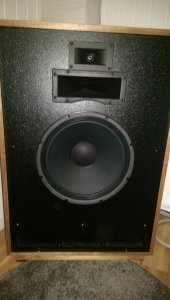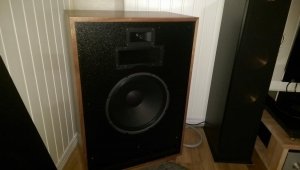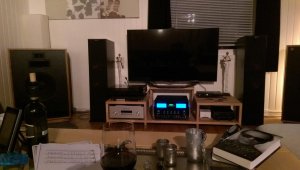Identifisering av Klipsch høyttalere
Ligger trolig i tråden fra før, men i stedet for å bla gjennom 24k innlegg:
KLIPSCH TYPES, FINISHES, SERIAL NUMBERS, DRIVER CODES & SELECTED PRODUCTION INFORMATION (V2.0):
GENERAL: This information generally applies to the Klipsch Heritage Series; but also includes, where applicable, selected information on finishes, grill cloth options and emblems/ logos used on most later models including those made after the 1990’s.The data is generally correct; and as additional information becomes available, this document will be updated on this thread. The author assumes full responsibility for errors.Sources include, but are not limited to:Discussions with Klipsch employeesSource material provided via KlipschKlipsch forum threads (extensive source material available)Klipsch reference documents and information sheets, data specs, timeline sheets, etc., that could be found in public domain) Corrections, additions, etc are most welcome, and as Klipsch owners and forum members contribute to this thread, the document will be updated.
HOW TO READ THE KLIPSCH MODEL & SERIAL LABEL CODES: All of the “labels” through 1990+ are functionally similar. The Heritage series until 1984 were relatively simple: they were hand written, and first line was the model and wood/finish type, and the second line was the serial number (serials discussed further below).Starting in 1984 and continuing until approximately 1990, the labels were similar, however used a “stamped” serial number identification below the model number.By 1990, the labels were “computer” generated, with the model number, finish and other coding included in a second “line”.
EXAMPLE: KC-BB 15T252This tag would be for a Klipschorn, Type-C (non-“collared”), serial number 15T252 (made in 1979).
KLIPSCH SPEAKER TYPE CODES: (HERITAGE ONLY)Below are the most common Heritage type codes.C = Cornwall (CD= "decorator" with flush motor board and no grill) BK = Belle Klipsch H = Heresy (HD = "decorator" with flush motor board and no grill) LS = La Scala KC = Klipschorn - no “collar” KB = Klipschorn - collared KD = designer type (no grill, not made after late 60's)
KLIPSCH SPEAKER WOOD/FINISH CODES:Until the late 70's-early 80's, customers could special order a number of exotic veneers. Until the late 70's-early 80's, customers could special order a number of exotic veneers. It should be noted that until May, 2001, as an example for Heresy’s, there were almost 100 different finish, grill cloth, and riser ‘combinations’ or variants that could be ordered. It is likely that the “list” is incomplete. In the mid-late 90's, Klipsch generally ceased special order veneers and raw birch was also discontinued on most models, except some Heresy-II's. Material for raw birch is/was Georgia-Pacific cabinet/furniture grade 7 ply (5 inner and the two outer fine grade plies). Risers for the Heritage series were originally optional, and there was a long base for horizontal placement standard on Cornwalls. Heresy risers were "straight" until the late 1980's, and were still an option until the late 90's and after that were standard, but only the "slant" style. Currently the US version Heresy is shipped with slant riser, elsewhere in the world they can be ordered with or without the riser. The Heritage series codes appeared after the letter designation; e.g C-WO is oiled walnut. The finish codes are after the type code, e.g KC-BB - Klipschorn, black lacquer finish. The first line of the tags reads Type, Wood, Finish.
CODE WOOD FINISH REMARKSAL Ash Lacquer AO Ash Oiled BB Birch Black LacquerBR Birch RawBW Birch White Lacquer Rare Spec OrderCL Cherry Lacquer CO Cherry Oiled DBR Birch Raw Designer (No Grill) DBB Birch Black Lacquer Designer (No Grill) EL Ebony Lacquer Rare Spec Order EO Ebony Oiled Rare Spec Order FL Fir Lacquer Rare FO Fir Oiled Rare FB Fir Black Lacquer Late Models OnlyF* Fir Firzite* Rare - Early (Marine Grade)HL Hickory Lacquer Rare Spec Order HM Maple Oiled Rare hard rock MH Mahogany Lacquer Rare Spec OrderMHR Mahogany RawML Maple Lacquer Rare Spec Order MO Maple Oiled MO* Medium Oak Oiled Late 90's Models OL Oak Lacquer OL Oak Oiled PNL Persian Nut Lacquer Rare Spec OrderPL Prima Vera Lacquer Rare Spec OrderPR Prima Vera Raw Rare - Early RL Rosewood Lacquer Brazilian RO Rosewood Oiled BrazilianRRL* Rosewood Lacquer Rare - Rambling Rose TL Teak Lacquer TO Teak Oiled TWL Tigerwood Lacquer Rare Spec OrderTWO Tigerwood Oiled Rare Spec OrderWL Walnut Lacquer WO Walnut Oiled ZL Zebrawood Lacquer Rare Spec OrderZO Zebrawood Oiled Rare Spec Order
KLIPSCH SERIAL NUMBERS:Notes:There have been a number of serial number data sheets posted on the forum. Based upon additional information, and in particular information relates to the use of letters starting in 1955, the 1962-1983 coding has been modified to reflect that information.July 29, 1955 was the last day for the four digit serials (i.e. 1811). After that the "number- letter-serial" system went into effect (2 August 1955).The first "number-letter-serial" speaker was produced on the 2nd of August 1955; that serial number was 1A812. The serial number was written on the paper serial tags and die stamped on the back edge of the top panel (inside top portion in LS). This practice was not used on later “MDF” cabinets for the Heresys, etc. Serial numbers can often be found written in pencil on the inside of some of the Heritage series, most notably Klipschorns and Belles.While the 1946-1961 manufacturing dates can only be found in the Engineering Library in Indianapolis, accurate specific dates for the day of manufacture may also be found by close examination of the interior of the speaker cabinets. As an example there were often small inspection tags stapled inside the cabinets and penciled notations with dates inside the cabinets. An example of the production inspection stickers was the use of “PRIDE” stickers inside some models. These were used in the early through mid-1980’s.Additional letters stamped in the edge grain of Heritage series made from birch plywood (and high end veneers that used poplar/ ash “lumbercore” as the substrate were USA and/or the cabinet builder’s and final sander’s initial(s). For reasons of protecting their right to privacy, I have not identified the names of those superb craftsmen (and women).In the 1955-1983 serials the following generally applies:The digits after the letter code were three digits. The first, or prefix “digit” (or two, or by 1983 there could be three dependent on the model) before the year letter is sequential for each 1000 units, and is related to that year. For example 1C999 would be the 999th unit built, and 2C999 would be the 1999th unit built in 1965 (Letter “C”).The first digit(s) basically apply to that production “run” of that type in a given year. By 1981, in this serial number system, one of the prefix digit(s) series was 112 (Heresy’s). This does not mean that by 1981, there were 112,000 Heresy (or Heritage) speakers made, it only means that in 1981, The 112th production run which included Heresy’s occurred. The year letter simply identifies the year in which that run occurred. As an example, if you have a pair of Klipschorns and the serial numbers are 15T252 & 253, then it is evident that by 1979, there had been 15 production runs in which Klipschorns were made, but not 15,252 Klipschorns made!If you have a pair of 1979 LaScala’s, and one of the serial numbers is, for an example, 22T403, it does not mean that 22,400 non-industrial LaScalas were made between 1962 and 1979, it only means there were at least 22 production “runs” in which LaScala’s were made, and “run” #22 just happened to occur in 1979.To emphasize this issue, a pair of Belles from 1979 have the serial number 3T243. This means that in 1979, the 3rd production run that produced the Klipsch Belles occurred. The quantities of any given production run are not available at this time. Based upon serial number research, many production runs until the late 70’s may only have had several hundred speakers in the “run”. From 1948 though 1961, Klipschorns had the serial number stamped into the tailboard, woofer access door, or inside the woofer chamber.In the early-mid 80's (generally starting in 1984), Klipschorns had two serial numbers assigned to each speaker; one for the bass bin and one for the top section. The bass bin had a "L/F" at the end of the "type code" (see further below) and the top section had a "H/F" at the end of the type code.Letters that look like numbers were not used. “S” is frequently misread as a “5” and Y has been confused with an X on occasions
DATES DESCRIPTION EXAMPLE
1946-1947 ### (ending #021)
1948-1961 #### (starting #0121)
1955-1983 ##letter#### 20Y1234
A = 1955-63* F = 1968 K = 1972 R = 1977 X = 1982 B = 1963-64* G = 1969 L = 1973 S = 1978 Y = 1983 C = 1965 H = 1970 M = 1974 T = 1979 D = 1966 I – Not Used N = 1975 U = 1980 E = 1967 J = 1971 P = 1976 W = 1981
* Cornwalls & LaScalas used “A” 1963 and “B” for 1964; The first Cornwall to use a letter code was 3A09, shipped in August of 1963.
1984-1989 YYWW#### 89261234YY = year (e.g 89 = 1989)WW = week of the year (e.g. 26= last week in June)
1990-1997 DOYY2Y1#### 135791234DOY = day of the year (e.g. 135 = 14 May)Y2Y1 = 2nd digit of year, 1st digit of year (e.g. 79 =1997)
1998- 2000 YY WW #### 00281234 YY = year (e.g 89 = 1989)WW = week of the year (e.g. 26= last week in June)
KLIPSCH DRIVER CODES:Driver Manufacturing Date Codes: (1994) Example: 9429 = 1994, 29th week of the year.Driver Manufacturing Codes: Example: K-33-E would be the "Klipsch", type 33 (15") woofer from Eminence B = CTS in Brownsville TX (woofers only) P = CTS in Paducah KY (woofers only) R = Rebuilt (K22's only) D = Starting in 2006, K-77-F (see below) designation change F = Unidentified vendor who purchased EV tooling (e.g. K-77-F) EV = Electro Voice (early K-33’s e.g. “EV-15WK”) G = (Unidentified vendor for K-55-G for Cornwall 1981-1983) J = Jensen H = Heppner (K-52-H in Cornwall-II’s) K = Klipsch (assembled by Klipsch or under contract for Klipsch) E = Eminence (Primarily woofers) V = Atlas (see also notes below) M = Electro Voice (also for the Eminence K-33-M in 1967) X = Atlas (e.g. K-55-X) Ti = Titanium series The suffix letter code generally referred to the origin of the driver.The V on the midrange & tweeters can also indicate 'video shielded'A significant number of "replacement" drivers, e.g. late model K-53's, K-76's will have no manufacturing code or date code, e.g. "blank" as in nothing at all.On some Heresy drivers, the number K57 indicates the driver/horn combo part number, which is a K52 driver and K701 horn. Electro Voice also produced the “round magnet” T-35 tweeter, but later versions were labeled K-77Electro Voice also produced a K-56 (EV-1828) as a temporary replacement for K-55’s in 1974. Generally found on Belles.Atlas produced the K-55X’s (PD-5VH) Stephens (P52LX2) woofers were used from 1949 through 1953 on the Klipschorns. In 1953, the Stephens P103LX2 was used. From 1950 through 1961, the Stephens woofers were used interchangeably with the Electro Voice EV-15WK woofer and the early Jensen K-33-J’s in the Klipschorns.
KLIPSCH GRILLS & CLOTH CODES:Notes: It should be noted that until May, 2001, as an example for Heresy’s, there were almost 100 different finish, grill cloth, and riser ‘combinations’ or variants that could be ordered.Early model Cornwall, all Belle and all Klipschorn grilles are cloth wrapped around the motor board and stapled to the back side of the motorboard. Installed with wood screws coming through braces in the cabinet sides.Cornwall Decorator series were later given various grille fittings. The first was a standard sized grille with Velcro tabs that would simply be surface mounted. In later years a trim kit with a grille was developed. Heritage grill backings (Cornwall, LaScala, Heresy) were made from (a) "masonite" fiberboard, or (b) a resin impregnated board (late model Cornwall & Heresy) Grill backings for the Klipschorn & Belle bass bins are 3/8” or ½” plywood, with a ‘cut out’ frame, with the cloth glued and stapled. Klipschorn side grills (until 2005) were retained with an “L” bracket, studs on the LF section lower panel and wingnuts.In 2005, the angle brackets, hanger bolts and wing nuts used to attach the HF and LF cabinets together on the Klipschorns were replaced with thick rubber spacers, on the LF cabinet, indexed into recesses on the HF cabinet.Later models (Forte, Chorus, etc.) grill backings are also made from polystyrene plastic, with cloth glued to reverse edges. These models, and KLF’s, Reference series, etc have the grills attached by means of plastic “pins” molded to the grill frame and plastic inserts on the motor board.The new Reference series and new Heritage series grills (except Klipschorns) are retained by magnets.Grill "velcro" varies between either 3/4" round or 1/2" x 3/4" rectangles. On Cornwalls, the “motor board" velcro pieces are sometimes stapled to the motor board.
#03 = Cane (Supposedly not available on Heresys or walnut Cornwalls) #13 = Heritage brown#15 = White/black coarse weave #16 = Pending #17 = Duracrest #17, black, poly-olefin, stranded, coarse weave (Heritage only) #18 = Duracrest #18, brown, poly-olefin, stranded, coarse weave (Heritage only) #19 = Duracrest #19, black, poly/ nylon, flat weave (Forte, Chorus, etc.)
KLIPSCH LOGO DESIGN (Note: Does not include Professional or Cinema): 1. There were/are three basic designs: pie slice in black/silver, clear/copper, and copper/black. Sizes and detailing varied as manufacturer/ contractors changed. The most recent (and current for the Heritage series) is the copper/black pie slice, sometimes referred to as the small "Jubilee" pie. The early pies also were made of clear plastic with copper or white lettering. copper with PWK logo and black lettering. the design varied slightly with the etching and lettering size varying in distance and size. Generally, smaller lettering was found in earlier designs. copper/bronze with subdued lettering, no "PWK" emblem on a background of horizontal stripes. These were generally seen in the mid 70's. Somewhat rare.There are also several sizes with a copper colored plastic with a raised Klipsch logo on black background used on KG series/ In addition, the ‘A’ line had a wide ‘V’ on the bottom with centered Klipsch and small PWK logo in copper or gold color as seen on the Epic series. The Synergy series used a black oval logo with raised Klipsch and ‘V’ of a variety of sizes.The logos were/are secured to the grills, centered usually within 1/2" to 3/4" from the top edge of the grill with types b & c, and either on the upper left or upper right for type a (pie slices). The glue used is a contact cement.Klipsch Parts still has the copper strip and the latest "pie slice" in stock to replace lost, damaged emblems.
. I Valnøtt
. Dyr men...
.
Vis vedlegget 411754 Vis vedlegget 411755 Vis vedlegget 411756 Vis vedlegget 411757 Vis vedlegget 411758 Vis vedlegget 411759
Vis vedlegget 411754 Vis vedlegget 411755 Vis vedlegget 411756 Vis vedlegget 411757 Vis vedlegget 411758 Vis vedlegget 411759
Hei Sjur
det morsomme synes jeg at det finnes masse kule og forsåvidt rimelige oppgraderinger/rwesks til disse
Identifisering av Klipsch høyttalereville prøvd det før bytting av elementer.











